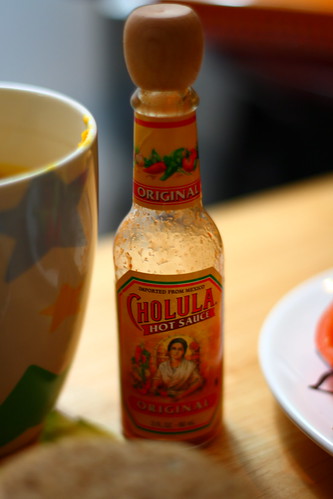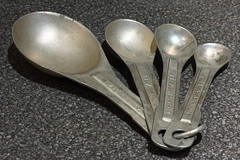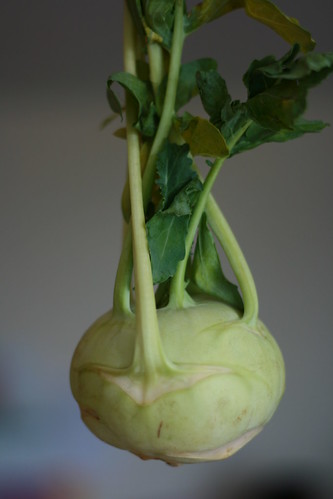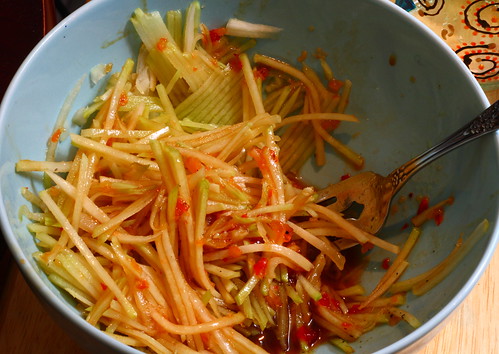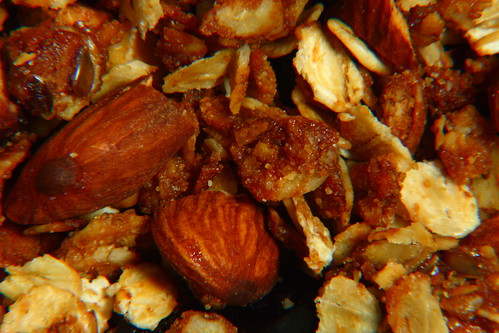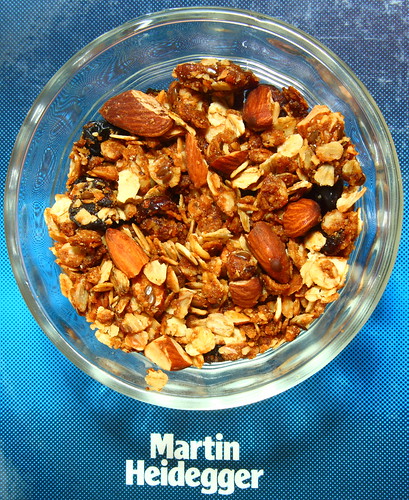Ever since foodwriter Tea mentioned gingerbread pancakes over a year ago (she’s since moved on to gingerbread waffles), I’ve been thinking of having them the next time I got to lay around and make D. cook. My birthday seemed a good time for that, since it landed on a Sunday.
Now, I adore gingerbread to a disturbing level, and would probably eat it for at least two meals a day if it were possible to do so and still fit through doorways. The third meal of the day would be composed of pancakes. Having gingerbread AND pancakes joined is indeed the perfect marriage (and possibly a way of saving at least two meals a day for things like plums and kohlrabi salad).
The only possible stem in the ginger is the fact that the pancakes must now be vegan, at least when I’m eating at home, and Tea’s original recipe calls for four eggs, and a quarter pound (!!!) of butter. Vegan pancakes can be tricky, too; I’ve eaten them lovingly and heavily prepared, and wanted fluffy, light cakes that I could load with flavor. And so, I did a bit of thinking.
Alton Brown has a really tasty sounding tempura recipe in which he suggests using seltzer water to make the batter fry up crispy and light. I also considered the fact that beer-battered rolls use the lifting effect of the bubbles to raise them, at least in part. Armed with those fuzzy assumptions, I rummaged in the fridge, and came up with a recipe.
Gingerhead Pancakes
- 2 C AP flour
- 1 Tbsp. baking powder, 1/4 tsp. baking soda
- 1/2 tsp. of salt
- 1 tbsp. ginger
- 1/8 tsp. cloves
- 1/8 tsp. nutmeg
- 1 C milk – I used soy
- 1 C gingerbeer
- 1 Tbsp. oil
In a medium sized bowl, mix your dry ingredients thoroughly. Combine milk, oil, and gingerbeer in a separate measuring cup, and use a spatula to fold it into the dry combination. After this point, I assume you know what to do with pancake batter.
These met with quite a bit of favor! They were light and fluffy and surprisingly tasty. The batch we tried with the Dandelion and Burdock brew of the Fentiman’s wasn’t as clearly gingery, but there are many more experimental herbal drinks where that one came from, and flavor isn’t entirely what we were after with using the effervescent drink — the lift was really good, and that’s what counts. To make these even more gingery, however, a tablespoon of fresh, grated ginger or chopped candied ginger might not come amiss. I can’t wait to try adding granola to these babies, which is my normal practice for pancakes. I like my pancakes light — and lumpy. Strange combo, that, but it works.
We don’t normally drink soda so it was a lucky indulgence that the bottle of Fentiman’s was on hand! We do try to keep a little plain seltzer water in the house, which would work just as well as soda in the batter but you might add a teaspoon of sugar to the mix, just to help the batter brown.
Aaaand, if you’re like us, and live in a country where maple syrup isn’t available without bartering limbs? You can make a reasonably good syrup by yourself. It just takes thinking about it, and a little planning and preparation. Preferably before you realize you want pancakes. Which we did not do. But, oh well. This was our first attempt at vanilla syrup.
Vanilla Syrup
- 1 C brown sugar
- 1 C white sugar
- 1 C agave syrup (or corn, if you prefer)
- 2 Tbsp. vanilla extract
- 1 Tbsp. margarine or butter
- 2 C water
- Place vanilla, sugar, and water in a small nonreactive saucepan and stir to combine.
- Bring to a gentle boil over medium-high heat. When the mixture boils, stir in butter, reduce heat and simmer until sugar is completely dissolved and syrup is slightly reduced, about 3 to 5 minutes.
- Allow to cool, and drain into a bottle for storage, or use warm. The syrup will further thicken as it cools.
The reason we used more than a single type of sugar is to keep the syrup from being able to solidify — combined sugars will keep it flowing. (Unless you have a fridge like ours, and it freezes. sigh.)
Our Martha Stewart-style vanilla is a big old bottle of vodka with scraped vanilla pods shoved in, so it’s quite intense of a flavor, and it really came through in this light and rich syrup. Our success has gotten us a little giddy — we can now imagine a citrus syrup with four tablespoons of lemon zest, and 3/4 c. of lemon juice. Or maybe a pear syrup, with a cup of pear juice to replace the brown sugar, and a teaspoon of cinnamon and one of cloves. Or peach syrup, with cold brewed Earl Grey tea instead of water… Whatever you try, enjoy it, and do tell!
Enjoy your pancakes with grilled fruit (or fresh), nut butter, and the syrup of your (second) choice. If you can’t have maple, this is reallyreally good. And if you can have someone you reallyreally like make all of this for you, then life is really, really sweet.












